

Invent Your Own Computer Games with Python. Www.seas.upenn.edu/~ese111/Fall2012labs/FinalProject-Part1. 4. Functions — How to Think Like a Computer Scientist: Learning with Python 3. 4.1.
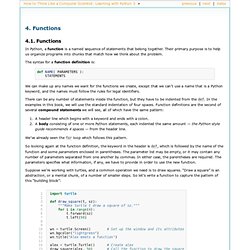
Functions In Python, a function is a named sequence of statements that belong together. Their primary purpose is to help us organize programs into chunks that match how we think about the problem. The syntax for a function definition is: def NAME( PARAMETERS ): STATEMENTS We can make up any names we want for the functions we create, except that we can’t use a name that is a Python keyword, and the names must follow the rules for legal identifiers.
There can be any number of statements inside the function, but they have to be indented from the def. A header line which begins with a keyword and ends with a colon.A body consisting of one or more Python statements, each indented the same amount — the Python style guide recommends 4 spaces — from the header line. We’ve already seen the for loop which follows this pattern. So looking again at the function definition, the keyword in the header is def, which is followed by the name of the function and some parameters enclosed in parentheses. Astronomical Python. Intended Audience Astronomers interested development of an interactive data analysis environment in Python.

Amateur astronomers interested in astronomical analysis tools that can run on computer systems within their budget. Students and teachers interested in a free and easy-to-use programming language for teaching. Astronomical Modules AstroPy. Charts Library — Vincent 0.4 documentation. Vincent provides a charts library that allows for rapid creation and iteration of different chart types, with data inputs from a number of Python data structures.

This library is built using the Vincent API to construct Vega grammar, with some adding conveniences for simple data input. Chart The Chart class is a base container for ingesting data and creating a Vega scaffold: Note the use of chart.grammar() to output the specification to Python data structures. If at any point you wish to view the current specification, use the grammar() call. 2.6. Image manipulation and processing using Numpy and Scipy — Scipy lecture notes. This chapter addresses basic image manipulation and processing using the core scientific modules NumPy and SciPy.
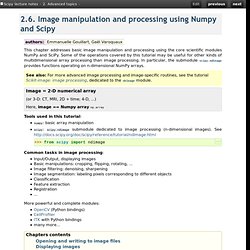
Some of the operations covered by this tutorial may be useful for other kinds of multidimensional array processing than image processing. In particular, the submodule scipy.ndimage provides functions operating on n-dimensional NumPy arrays. Image = 2-D numerical array (or 3-D: CT, MRI, 2D + time; 4-D, ...) Txtduino/txtduino.py at master · jewelia/txtduino. Mcsp.wartburg.edu/zelle/python/graphics/graphics.pdf. Www.ucs.cam.ac.uk/docs/course-notes/unix-courses/pythontopics/graphs.pdf.
M.eet.com/media/1172271/convert your smartphone into a pedometer.pdf. Controlling Arduino with Python. Python Object Oriented. Python has been an object-oriented language since it existed.
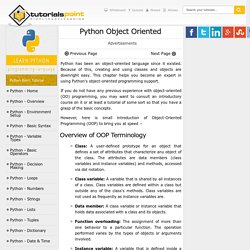
Because of this, creating and using classes and objects are downright easy. This chapter helps you become an expert in using Python's object-oriented programming support. If you do not have any previous experience with object-oriented (OO) programming, you may want to consult an introductory course on it or at least a tutorial of some sort so that you have a grasp of the basic concepts. However, here is small introduction of Object-Oriented Programming (OOP) to bring you at speed − Overview of OOP Terminology.
Python recipe: open a file, read it, print matching lines . palewire. There are a couple great books available free online but it's pretty tough to start stringing all the fundamentals into a problem-solving script all on your own.
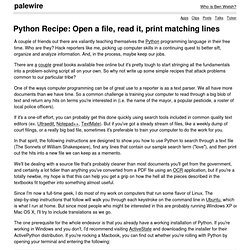
So why not write up some simple recipes that attack problems common to our particular tribe? One of the ways computer programming can be of great use to a reporter is as a text parser. We all have more documents than we have time. So a common challenge is training your computer to read through a big blob of text and return any hits on terms you're interested in (i.e. the name of the mayor, a popular pesticide, a roster of local police officers). Why are Python's 'private' methods not actually private. Learn Python The Hard Way, 3rd Edition. Python is called an "object-oriented programming language.
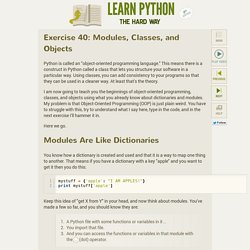
" This means there is a construct in Python called a class that lets you structure your software in a particular way. Using classes, you can add consistency to your programs so that they can be used in a cleaner way. At least that's the theory. I am now going to teach you the beginnings of object-oriented programming, classes, and objects using what you already know about dictionaries and modules.
How to Use Terminal: The Basics. Glowing monitors filled with lines of scrolling green text aren’t limited to The Matrix; most IT gurus and power users prefer working with the command line over clunky graphical user interfaces because the CLI allows the user to operate directly with the system.

While the command line can seem terrifying at first, starting at the basics will allow you to see that it’s not much different from the graphical world you are used to. Learning how to use Terminal will give you a better understanding of how your Mac works under the hood, and give you the skills needed to troubleshoot any issue. Choosing a Terminal Emulator Before you take the red pill and jump into the complex world of bins and bashes, you’ll need to choose a terminal emulator. Like web browsers, various emulators have different features and interfaces. Hacking Secret Ciphers with Python - Chapters. Chapter 1 Read online: Chapter 1 - Making Paper Cryptography Tools PDF of the Caesar Cipher WheelInteractive Virtual Cipher Wheel Chapter 2.
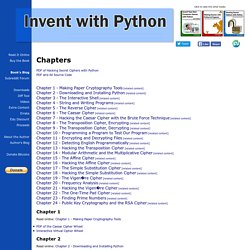
Coweb.cc.gatech.edu/cs1315/uploads/807/Chapters1-3-pre-release.pdf. RGB Colors in Python. List Comprehensions in Python. Python Study Guide Flashcards. Carl Groner > An Introduction to List Comprehensions in Python. Structuring Your Project — The Hitchhiker. By “structure” we mean the decisions you make concerning how your project best meets its objective.
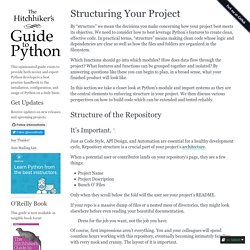
We need to consider how to best leverage Python’s features to create clean, effective code. In practical terms, “structure” means making clean code whose logic and dependencies are clear as well as how the files and folders are organized in the filesystem. Which functions should go into which modules? How does data flow through the project? What features and functions can be grouped together and isolated? In this section we take a closer look at Python’s module and import systems as they are the central elements to enforcing structure in your project. Structure of the Repository It’s Important. Just as Code Style, API Design, and Automation are essential for a healthy development cycle, Repository structure is a crucial part of your project’s architecture.
When a potential user or contributor lands on your repository’s page, they see a few things: Topical Software — SciPy.org. This page indexes add-on software and other resources relevant to SciPy, categorized by scientific discipline or computational topic. Download/robust_python_programs_europython2010.pdf. Non-Programmer's Tutorial for Python 3/Lists. Variables with more than one value[edit] You have already seen ordinary variables that store a single value. However other variable types can hold more than one value.
These are called containers because they can contain more than one object. The simplest type is called a list. Here is an example of a list being used: which_one = int(input("What month (1-12)? And an output example: What month (1-12)? In this example the months is a list. months is defined with the lines months = ['January', 'February', 'March', 'April', 'May', 'June', 'July', and 'August', 'September', 'October', 'November', 'December'] (note that a \ could also be used to split a long line, but that is not necessary in this case because Python is intelligent enough to recognize that everything within brackets belongs together). The statement if 1 <= which_one <= 12: will only be true if which_one is between one and twelve inclusive (in other words it is what you would expect if you have seen that in algebra).
The section.